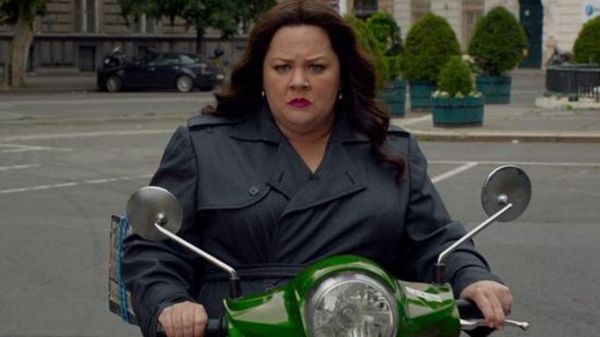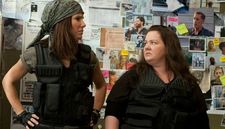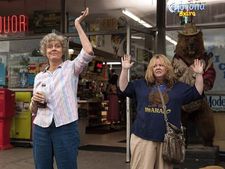 |
| Melissa McCarthy gets on her bike in Spy. |
Cagney And Lacey it is not. But do negative reviews for Hot Pursuit mean it’s really a turkey – or do they highlight a failure on the part of a mostly male critical academy to “get it”?
For the last couple of years have seen a mainstreaming of the Bechdel test into a genre – the buddy (cop) movie - that has hitherto been a distinctly laddish preserve.
Recent manifestations of this trend include both Spy and The Heat, which, like most buddy movies, rely for basic premise on an odd coupling. In The Heat, uptight Sandra Bullock with sassy street-smart Melissa McCarthy: in Spy a rather more grounded McCarthy teamed with gawky best friend Miranda Hart, as well as a host of strong female co-stars.
 |
| Taking the wheel in Hot Pursuit |
Two films does not a genre make. But there are others, ever so slightly outside the law enforcement envelope: Tammy, also starring Melissa McCarthy, alongside Susan Sarandon as her eccentric and crotchety grandmother. There is the bond that eventually forms between the princess, Aurora, and Maleficent in the movie of the same name. And then, a step or two further along the road, there is the sister relationship between Elsa and Anna in Disney’s uber-successful Frozen.
Sisters! There’s a strong clue to what is going on here. As Miranda Hart explained in a recent Time interview about her role in Spy. She told the magazine: “It [friendship] was really important to me and Melissa.
“We talked about how we wanted make sure that that was the core of their scenes together - this real sisterly love.”
The result so far has been frequently dismissed as no more than a new take on old, a reinvention of the latter with girls taking on the guy roles - but perhaps the fact that these films just “do not compute” with so many male critics suggests we are starting to see the emergence of something genuinely new and different.
I watched Hot Pursuit the other night with a friend who sprang it on me as a surprise: so unlike with most movies that I view while wearing my critical hat, I had no idea what I was going to be seeing. And I loved it.
 |
| Sisterly love in Frozen |
As, one could tell from the approving chuckles (and occasional very dirty laugh) of the mostly female audience, did most of the other women there. After, I read some IMDB reviews: small sample stuff, but the first two reviews from identifiable guys awarded 1 or 2 out of 10: the first two reviews by women scored a straight 10.
I was struck by how many of the former made the same (wrong) point: we’ve seen it all before; nothing new here. Only we haven’t.
I don’t just mean the somewhat icky menstruation routine by which Reese Witherspoon and Sofía Vergara effected their escape from the bad guys at one point.
The joke was clearly on the men, and their ignorance of the issue: and in a week when Donald Trump thought it an appropriate put-down to suggest Fox News anchor Megyn Kelly had "blood coming out of her wherever”, and twitter was buzzing with comment on a ‘freebleeding’ marathon runner, about time too!
Beyond that, though, we are seeing a shift to the style and content of the humour: there is a lot more exploration of relationships, which often act as backdrop to the emerging sisterhood. Exploration, too, of how to be a woman: in many instances, the start point is two very different women forced together by circumstance and initially very judgmental of each other’s choices. Resolution is then a gradually dawning realisation on the part of each that the other has a point, too.
Sometimes, there is a breaking of stereotypes. Tammy, for instance, included one of the first and most realistic representations of a lesbian social gathering I have seen in a mainstream movie: a party, hosted by a long-term lesbian couple, actually resembled similar events I have attended.
 |
| Ready for action in The Heat |
Not all these films are directed by women, but female influence at either script or director level is palpable. Equally, almost all these movies have one or more strong established women at their heart. With three major “sister” movies under her belt (not even counting Bridesmaids), Melissa McCarthy is clearly seeking to make these her own.
But you don’t mess with Sandra Bullock, either. Nor Angelina Jolie, nor Susan Sarandon, nor Reese Witherspoon.
Of course, we have had “women’s movies” for a long time: deep, meaningful endeavours, such as Steel Magnolias or Fried Green Tomatoes.
But this new species of sister movies is not so serious that it topples into the pit labelled “worthy”, nor so unserious that it can be dismissed as “just for women”, consigned to the pink fluffiness of romcom or “chick flick”.
Sure, Reese Witherspoon may end the film by getting her man, but that entire sub-plot is kept off screen and relegated to the side issue it really is: something that she and Sofia Vergara may giggle over, but in no way central to the narrative. Likewise, the high at the end of Spy is not Melissa McCarthy getting her man, or even – since she appears to be an object of lust to several men throughout the film – taking her pick, but her promotion to full field agent.
OK. Not entirely true. She does win herself a shag, though not quite how she imagined it. And the underlying message remains clear: career and a cup of cocoa take precedence.
 |
| Susan Sarandon and Melissa McCarthy have one of those days in Tammy |
Why now? Perhaps it is simply an idea whose time has come, in a way it had not, back in 1991, when Thelma And Louise took to the road. Or, more recently, in a film whose very title seems to presage what is now happening: Sister Act.
Though perhaps there, too, lies a clue to what has changed in the intervening years. These films may outwardly pass the Bechdel test when reviewed in detail, scene by scene, line by line. Women very definitely occupy foreground and centre stage.
Yet pull back to reveal a less palatable truth: they are still all about the invisible man. So, in 1980, when Nine To Five showed women taking revenge, the motivation and jumping off point remained the bullying boss in the background. Even when not explicitly in film, the male presence lurks in the form of a male gaze lingering over the action, reducing every attempt at empowerment with “Look! Women doing it for themselves: isn’t that exceptional?”
There are striking similarities here to the journey travelled by black actors in historically white genres. Sidney Poitier in In The Heat Of The Night represented a breakthrough. But as long as his presence on screen was prefaced with terms like “ground-breaking”, there was work to do. A real breakthrough was Will Smith and Martin Lawrence in Bad Boys (1995), who are “just there”, as another buddy cop pairing.
What is different is that Hollywood, with one eye, perhaps, on the success of stage show Wicked, has finally realised that there is a mainstream audience for sisterhood - even for feminism. It is possible to deal with women on screen without shunting such films off into a slightly scholarly ghetto labelled “women’s film”
More, women’s films can now be about ordinary women doing exactly the same things as men do – and that, in the end, is what makes films like Hot Pursuit new and different.





















